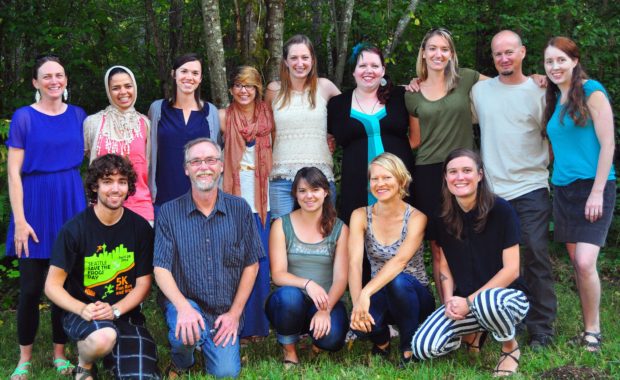By Sadie Gilliom, SPP Turtle Rehabilitation Program Coordinator
When Rachel Stendahl started work with the Sustainability in Prisons Project in 2013, her dream was to become a marine ecology professor. However, something about her experience as an SPP Roots of Success Coordinator must have stuck: in the years since she left SPP, she figured out how to bring environmental education to juvenile detention centers!

Rachel Stendahl talks with a Roots of Success instructor during a graduation celebration for students of the environmental curriculum. Photo by Joslyn Rose Trivett.
After researching the relationship between paths of whale migration and shipping, Rachel graduated from The Evergreen State College with a Master’s degree in Environmental Studies. Rachel was hired by Educational Service District 113 to be their Regional Science Coordinator. She took over the job of running a watershed education program called the Chehalis Basin Education Consortium. This program supports stewardship of the Chehalis Basin watershed by providing environmental education resources to educators. Through this program, hundreds of youth throughout the Chehalis Basin watershed learn how their watershed works, how to test the water quality of their streams, rivers, and lakes, and how to present their water quality data.
After getting into the swing of things, Rachel realized that not all of the students in the Chehalis Basin were being provided these same hands-on learning opportunities. In particular, she was concerned with the students inside of juvenile detention centers. With the help of another previous SPP employee, Bri Morningred, Rachel successfully completed, submitted, and was awarded the No Child Left Inside grant. Rachel began to implement a new environmental education program at the Lewis County Juvenile Detention Center.
SPP shared Rachel’s internship opportunity on their listserv and I applied for the job. We worked together to coordinate the first-ever environmental education program provided to the youth at the detention center. It has been a great success! Rachel plans to continue the program and hopes to expand to Green Hill Juvenile Detention Center. Go Rachel!

Erica Turnbull, an SPP intern from Western Washington University, and Rachel studied reentry together during the summer of 2013. Photo by SPP staff.








 Graduation brings an end to student-staff employment. Each coordinator trains their successor, which is as much about introducing them to the culture and ways of thinking as it is about program policy and protocols. Each turnover is bittersweet. We have to say good-bye to someone we have relied on and invested in, and it is painful to see them go.! At the same time, we get to welcome someone new, and their fresh perspectives helps SPP to continually improve; we can’t get stale! Also, there is the satisfaction of seeing SPP alumni go on to new and valuable endeavors, and we take pride in supporting their ongoing careers and aspirations.
Graduation brings an end to student-staff employment. Each coordinator trains their successor, which is as much about introducing them to the culture and ways of thinking as it is about program policy and protocols. Each turnover is bittersweet. We have to say good-bye to someone we have relied on and invested in, and it is painful to see them go.! At the same time, we get to welcome someone new, and their fresh perspectives helps SPP to continually improve; we can’t get stale! Also, there is the satisfaction of seeing SPP alumni go on to new and valuable endeavors, and we take pride in supporting their ongoing careers and aspirations.

































